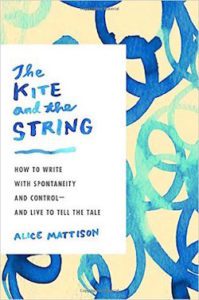
I’ve been working on a novel for what seems, to someone used to short stories, like an impossible stretch of time. I’ve toted drafts of it across three continents, hunched over it in four apartments, and begrudged four jobs for keeping me from spending more time with it, and still it’s not done. The confidence I felt when drafting the first half of it five years ago at my MFA program—that feeling that even though I hadn’t published much yet, I was a writer writing, a craftsman crafting—has faded. That program taught me many things, but I didn’t leave there prepared for the long, solitary haul of a novel. The only thing that has defined me as a writer for a long while now is the fact that I show up at my desk, which I realize should be enough, but somehow it isn’t, and sometimes I fantasize about how nice it might be to stop caring, to ease into Pokémon Go and the clickable comforts of my Netflix queue.
Which is all to say that I needed to read a book like Alice Mattison’s The Kite and the String. Mattison, a writing instructor at Bennington College and the author of six novels, four collections of short stories, and a collection of poetry, openly states that this is not a book for beginners, but for people who have “worked at this art,” and that her goal is to help us come to it with “more confidence, excitement, and hope”—all the things I’ve been lacking. As such, the book is not an instructional guide so much as a mulling over, not a how-to so much as a reflection on how to be happy, or at least productive, as a writer. There are no hard and fast rules and no separately listed prompts or exercises, no directives from the mount and no mandates from the guru. Nothing as easy as that. Instead, Mattison walks us through the writing process from idea to drafting to revision, offers possible forms for stories, carefully considers issues she’s noticed while teaching, then wraps up with proposals for how we might get our minds and expectations right. She touches on subjects that I haven’t heard discussed very often in books on writing, subjects like the narrative possibilities of coincidence and the need for lifting the silence from hushed characters and oppressed writers. She also argues against certain habits or ruts: against passive characters, against indirect narration, against writing your first draft with theme in mind. What she says we need most of all is to be able to to toggle between two “contradictory states of awareness”: an intense, free flow for drafting and a common-sense, intuitively analytical frame of mind for revision. The kite, for her, is creative freedom, the string common sense. We need, Mattison argues, “abandon and control—a kite that takes off into the wind, a restraining string that’s unspooled a little at a time and pulled when necessary.” We need to let our imaginations take off, but we also need to step back and look carefully at what we’ve produced.
Throughout the book, Mattison’s pace is light but thorough. She introduces most sections with a personal anecdote, makes her argument, gives an example, then moves swiftly on to a new topic. This loose yet contemplative style gave me many ideas regarding my current and future stories and my process in general, which is probably all you can ask for from a book on writing. The only time Mattison’s swiftness caused a problem was when she discussed genre. “There’s nothing wrong with genre fiction,” she writes, “if that’s what you’re in the mood for, but its very nature—its delight in adventure, intricate plot, or thrilling departures from reality—keeps it from being a study of character with the potential for tragedy.” The italics are mine, because I can’t imagine anyone saying that without tenting their fingers, raising the point to their chin, and nodding sagely afterwards. It’s a disappointingly lazy argument for a book so otherwise full of nuance, an argument that rests on the tired old idea that literary fiction focuses on character and genre fiction on plot. There’s not much Mattison discusses that couldn’t be applied by writers working on stories featuring nefarious elven kings or roguish cowgirl spaceship captains. She argues that literary fiction should have plot, but she doesn’t seem to be able to conceive of a story with genre tropes that also features fully developed characters. The one example of genre she gives—three sentences on P.D. James’s An Unsuitable Job for a Woman—is so laughably brief and from 1972 that you’d have to try pretty hard to take it seriously.

Still, it doesn’t take much effort to look past such slight slights and find something to connect with in The Kite and the String. Mattison provides us with several looks into writers’ processes, and her description of George Eliot’s was especially comforting. While beginning Middlemarch, Eliot became stuck and frustrated, so much so that she had to write self-bolstering notes in her journal such as “I have need to remember that other things which have been accomplished by me, were begun under the same cloud” and “Courage and effort!” She started a notebook containing research and lists that she referred to as her “quarry,” lists on character names and professions, relationships, plot points, and backstories—each one, Mattison writes, “the bones of a book.” At one point there was a sixteen-month break when she didn’t work on Middlemarch at all while she traveled, wrote poetry, and grieved the death of her partner’s son. Her progress only really resumed after she drafted a completely different story, one involving a new character named Dorothea Brooke, which she eventually realized was the other half of her novel. It’s good to be reminded every once in a while that even the writers of classics often were interrupted, often had doubts, and usually had to intuit their way to the completion of their work, with allowances for false starts and long pauses along the way. As Mattison put it, writing is not something you get right and know how to do once and for all, like tying your shoes. So it’s OK if it takes time to figure something out. It’s OK if it takes ten years and thirty drafts. Some good things cannot be reached with one click of the mouse or one tap of the remote or one swipe on your phone. Some good things take a daily, almost monkish level of commitment. That’s how it should be, and that’s worth your time. The thing you’re writing may seem impossibly stuck right now, but you’ll figure it out with time and work and patience.
A few weeks before I left education to return to the corporate world this April, I saw a student of mine, a fourth-grade girl from India who I worked with twice a week on her English, flying a kite with her father and his friends in the seminary parking lot up the road from the school. Few people drove through the lot except for teachers and seminary students, so she was safe to stand among the cracks and painted lines and smile up at her kite in the wind. I asked her several times after that if she’d flown her kite again, and several times she told me no. The wind and the weather had not been right. Since I graduated from my MFA program, my friends and family have often asked me if I’ve been writing, and I tell them I have, which is true, but I can count on one hand the number of times I’ve let the wind catch my kite. Mostly my kite sits on the shelf where the lit mags containing my handful of published stories gather dust, and I sit at my desk tying the string in knots, interviewing authors, writing reviews, and compulsively rewriting the same chapters again and again. Mattison’s The Kite and the String was a much-needed reminder to relax my control, to commit the space and the time then sit back and let the string unspool.




